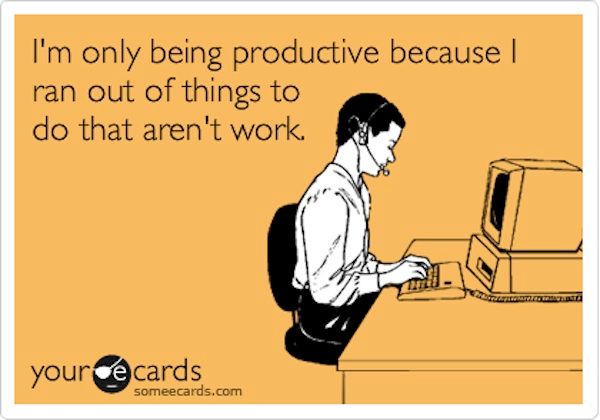A journey into the apps that promise to enhance productivity, that is, the only thing that matters (Originally published in Italian on Prismo).

The Isolator, avant la lettre productivity tool.
Here you are. Landed through Facebook during one of the several breaks from study or work you couldn’t resist to take. Sometimes you don’t even notice: suddenly you stop scrolling and, like a sleepwalker, you ask yourself: "What am I doing here?" You look at the clock and realize that the whole afternoon was wasted. You swear at Facebook, at Twitter and at the people who post stuff there. Specifically, I blame infinite scroll, a technology that mutates webpages into bottomless pits.

Thank you very much, Infinite Scroll.
StayFocusd
The good news is that we are not alone and, since this time-sucking automatism is extremely common, there are those who propose solutions. More than half a million users downloaded StayFocusd, an extension for Chrome created by Warren Benedetto, a developer who "[hasn’t] had any spare time since 1994". StayFocusd is simple: you select the time-consuming sites and decide how much time per day you can spend on them. When the time expires, social networks and the like disappear replaced by a white screen that includes a big header asking you: "Shouldn’t You Be Working?"

StayFocusd is even able to monitor the links reached via time-sucking websites. So, no more Onion scoops and Buzzfeed listicles. Of course, users are tempted to change the settings each time they need a few more minutes, for example when they receive a message on Facebook. If this is the case, StayFocusd proposes a challenge consisting in retyping, without the slightest error, the following text:
The procrastinator is often remarkably optimistic about his ability to complete a task on a tight deadline; this is usually accompanied by expressions of reassurance that everything is under control. (Therefore, there is no need to start.) Lulled by a false sense of security, time passes. At some point, he crosses over an imaginary starting time and suddenly realizes, "Oh no! I am not in control! There isn’t enough time!"
StayFocusd is much appreciated. For a user, it has been "sadly, the only way to end the university". Many speak of a cure for social media addiction, as in the case of a very satisfied user who attempted to publish a tweet about it. And StayFocusd didn’t allowed him: epic win! However, some argue that the lapidary "Shouldn’t you be working?" might be unprofessional. On the contrary, it is the dream of any supervisor: letting the software do the rebuke while being able to know exactly when the employee has tried to focus and failed.
Productivity Owl
Among this kind of coercive apps, there are some very imaginative ones. My favorite is Productivity Owl, an extension that embeds an owl on a perch into every webpage. At the end of the allotted time (30 seconds by default), the owl soars and heads for the current tab in order to close it. If you are nimble enough you can stop it. However, after a few seconds the owl will insistently start crying and eventually it will liberate to complete its mission.

Time is up ¯\_(ツ)_/¯
The obvious disclaimer is that this is an extremely annoying app. Besides twirling in the browser, the owl requires users to earn its respect. How? Living up to one’s intentions, that is, by avoiding to constantly change the app settings. The creator of ProductivityOwl claims that he lived for seven years below the poverty line because of his inefficiency. How can you blame him?
Freedom
Another typology of apps allows users to monitor their online activity and to extrapolate a detailed picture in which productivity and distraction are expressed in percentage. RescueTime, among the most popular ones, assigns a productivity score to each visited page: Google is considered neutral, Wikipedia and LinkedIn are productive, while Tumblr is very dispersive, like news sites and the shopping ones.

Half an hour of RescueTime.
The digital solutions to the problem of distraction abound. There is Freedom, which goes whole hog and blocks the connectivity for a certain period of time. There is Isolator, which obscures all windows and icons other than the chosen one. There is ChatterBlocker, which plays relaxing sound effects protecting you from office chatter.

Isolator in action. The background color can be changed.
Techniques of the Pomodoro

The App Store as grocery.
App stores are filled with tomatoes. For this, we must thank Francesco Cirillo, a developer and entrepreneur "who has dedicated his life to helping others improve their productivity." Cirillo is the inventor of the Pomodoro Technique, a time management method which essentially consists in a simple series of actions: identify a task, set a timer (possibly a tomato-shaped one, hence the name) to 25 minutes, work on a task until time runs out, take a short break, set a new tomato, and so on for four times, after which take a longer break.

Francesco Cirillo with the ubiquitous tomato and other complicated stuff in the background.
Conceived in the late ’80s, when Cirillo was still a student, the Pomodoro Technique anticipated by far the advent of social media. But its popularity does not seem to decline. However, criticisms are not lacking: according to the entrepreneur and ‘performance coach’ Jameson Brandon, the obligatory break is counterproductive because some tasks may require more than 25 minutes. Furthermore, the method may provoke a form of tomato addiction, that is, focusing more on the imposed limit rather than on the very task to perform.
Don’t Break the Chain

Task completed!
What has Jerry Seinfeld (yes, that Seinfeld) to do with this subject? Well, he also invented a technique to be more productive. Called Don’t Break the Chain!, it informs countless apps and online services. Here’s how it works: you identify a task that you intend to pursue for some time, then you buy a calendar on which you draw a big X for each day in which you actually perform the above task. If you are consistent, the Xs will form a long chain. The goal, at this point, is not to break it. In order for this technique to be effective one must have a clear purpose, identified from the start, and directly translatable into a task. Jerry Seinfeld has employed the technique to write new jokes and monologues every day, including the following one, ironically dedicated to the inability to save time.
Through a more or less explicit psychological terrorism and a series of ingenious forms of castigation, the apps and methods I described promise a better work/life balance by optimizing the production process. But they are not without limitations and side effects. Such systems are fighting what we call procrastination, but what is it exactly? According to some researchers, procrastination has three main characteristics: it is counterproductive, unnecessary, and it causes delay. The problem is that, in an era that is no longer characterized by a clear threshold between work and leisure, any period of recreation, leisure, rest, boredom or contemplation meets these criteria. There is always something more important to do and this causes anxiety and guilt. Can we identify a more substantial cause to these feelings? Broadening the view, the concept of procrastination can be seen as the product of a rationalistic approach that privileges efficiency: without the emphasis on productivity, the harmfulness of procrastination partially dissolves.

Already in ’69, Adorno understood life as a whole as endless work.
You’ve just arrived at the bar when you receive an email from your boss. It’s urgent. The people around you understand it from the look on your face lit by the smartphone.
The erosion of the boundary between work and leisure is not new, but something has changed: today we quantify our spare time adopting the same logic that informs the tools used during work time. Instruments that often require an active feedback, making productivity a part-time job in itself. Also: we independently decide to do so, since we have internalized the chronometer. A bit like in the Isolator app, leisure becomes an unfathomable black hole. It is nothing but absence of production, the absolute parameter according to which we measure every activity.

Technology doesn’t necessarily have to increase efficiency. Artist and programmer Sam Lavigne, in perfect Luddite style, exploits the hardware limitations to escape the totalizing urge to be productive. Slow Hot Computer is a site that dramatically slow your computer down, by making it perform laborious operations. In this way, you can’t work with it anymore. Among the enemies of productivity, there is also Kenneth Goldsmith, the poet who seeks to re-evaluate the time wasted on the internet, since he considers it a precious creative moment. And there would be many more, but 7 minutes and 33 seconds on average have already passed. It’s time to go back to work.

Screenshot from Slow Hot Computer, taking it wasn’t easy.
